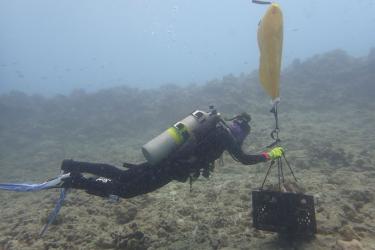Climate change is threatening coral reefs worldwide. The accelerated pace at which ocean temperatures have risen since the 1980s is causing coral bleaching and contributing to widespread loss of reef ecosystems. Even when it isn’t deadly to corals, bleaching can interrupt growth and reproduction, and leave surviving corals more vulnerable to diseases.
Coral Bleaching Is Occurring more Frequently in Hawaiʻi
Across the Hawaiian Archipelago, coral bleaching has increased in frequency and severity since 1996. The last major bleaching event in 2014–2015 had catastrophic impacts state-wide. Increased ocean temperatures set off another mass bleaching event in Hawaiʻi that spanned late summer through the fall of 2019. This was the third major bleaching episode in Hawaiʻi over the last 6 years. The frequency of these events is unprecedented in the archipelago. NOAA scientists and partners have determined that the key drivers of the bleaching were environmental factors (such as heat stress, depth, and surface light) and human impacts (sewage effluent and urban run-off).
A Comprehensive Response
Understanding what drives bleaching and how these events impact corals is critical for predicting the state of future reefs. In partnership with the Hawaiʻi Coral Bleaching Collaborative, NOAA scientists conducted surveys of coral bleaching across the Archipelago during the 2019 event. The Hawaiʻi Coral Bleaching Collaborative is a multi-institutional group of scientists across the state from academic institutions, non-governmental organizations, and governmental agencies. Together, the Collaborative conducted 2,177 coral bleaching surveys.
Scientists from NOAA and Cooperative Institute for Marine and Atmospheric Research, along with partners from the Collaborative, analyzed the bleaching data. They measured spatial variation in bleaching, compared 2019 results to bleaching recorded during 2014 and 2015, and examined taxa-level patterns in bleaching susceptibility. They also investigated variation in heat stress over time. They determined the key drivers of bleaching in 2019, and their research was recently published in PLOS ONE.
What Happened During the 2019 Bleaching Event, and Why?
Certain corals were more susceptible to bleaching than others, like the mounding Porites sp., whereas branching Pocillopora sp. tended to bleach much more readily. The presence of these species in 2019 was related to whether or not they survived bleaching in 2014 and 2015 as the past events shape future coral reef community composition. The bleaching was driven by a combination of environmental factors (such as heat stress, depth, and surface light) and human impacts (sewage effluent and urban run-off).
2019 Was Not as Hot as 2014 and 2015
In the Main Hawaiian Islands, the 2019 bleaching event was neither as long nor as hot as the 2015 event. Conversely, some reefs in the Northwestern Hawaiian Islands experienced higher accumulated heat stress in 2019 than in 2014. Yet overall, the bleaching observed archipelago-wide was not as extreme in 2019 as it had been in 2014 and 2015.
While the less severe bleaching observed in 2019 was good news for corals in Hawaiʻi, predictions suggest more frequent and severe heat stress events in the future. This research is an important step towards gaining understanding of coral bleaching. It will serve to inform management and conservation efforts in Hawaiʻi in light of likely future heat waves.
Funding to support this work was provided by:
- NOAA Coral Reef Conservation Program
- Sport Fish Restoration Program
- NOAA West Hawaiʻi Integrated Ecosystem Assessment
- Lenfest Ocean Program and Vulcan Inc.
- Harold K.L. Castle Foundation
- NOAA Office of Habitat Conservation







